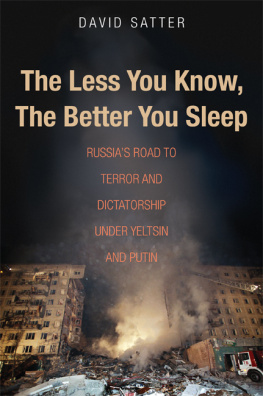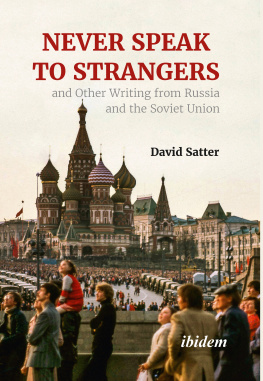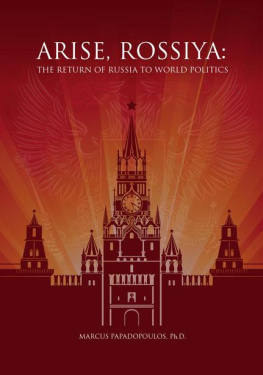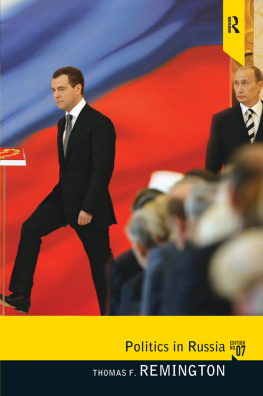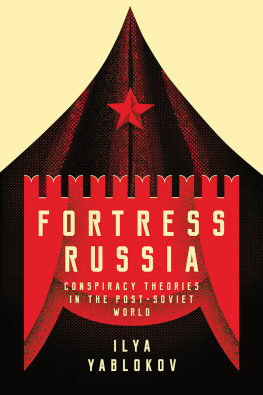IT WAS A LONG TIME AGO,
AND IT NEVER HAPPENED ANYWAY
It Was a Long Time Ago,
and It Never Happened Anyway
Russia and the Communist Past
David Satter
Yale
UNIVERSITY PRESS
New Haven & London
Copyright 2012 by David Satter.
All rights reserved.
This book may not be reproduced, in whole or in part, including
illustrations, in any form (beyond that copying permitted by Sections 107
and 108 of the U.S. Copyright Law and except by reviewers for the public
press), without written permission from the publishers.
Yale University Press books may be purchased in quantity for educational,
business, or promotional use. For information, please e-mail
sales.press@yale.edu (U.S. office) or sales@yaleup.co.uk (U.K. office).
Set in Galliard Oldstyle type by Keystone Typesetting, Inc.
Printed in the United States of America.
Library of Congress Cataloging-in-Publication Data
Satter, David, 1947
It was a long time ago, and it never happened anyway :
Russia and the communist past / David Satter.
p. cm.
Includes bibliographical references and index.
ISBN 978-0-300-11145-3 (cloth : alk. paper)
1. Soviet Union History 1925-1953. 2. Atrocities Soviet Union
History. 3. Atrocities Soviet Union Public opinion. 4. Communism
Soviet UnionHistory. 5. CommunismSoviet UnionPublic opinion.
6. Public opinion Russia (Federation) 7. Kommunisticheskaia partiia
Sovetskogo Soiuza History. 8. Soviet Union. Narodnyi komissariat
vnutrennikh delHistory. 9. Soviet Union. Komitet gosudarstvennoi
bezopasnosti History. 10. Stalin, Joseph, 1879-1953. I. Title.
DK267.S24 2012
947.0842 dc23
2011022685
A catalogue record for this book is available from the British Library.
This paper meets the requirements of ANSI/NISO Z 39.48-1992 (Permanence of Paper).
10 9 8 7 6 5 4 3 2 1
For Raphael, Claire, and Mark

I would have wanted to recall them all
by name
But they took the list and theres
nowhere to find it
Anna Akhmatova, Requiem
(translation by the author)
CONTENTS
CHAPTER 1
The Statue of Dzerzhinsky
CHAPTER 2
Efforts to Remember
CHAPTER 3
Butovo and Kommunarka
CHAPTER 4
St. Petersburg
CHAPTER 5
The Appeal of Communism
CHAPTER 6
The Responsibility of the State
CHAPTER 7
The Trial of the Communist Party
CHAPTER 8
Moral Choice under Totalitarianism
CHAPTER 9
The Roots of the Communist Idea
CHAPTER 10
Symbols of the Past
CHAPTER 11
History
CHAPTER 12
The Shadow of Katyn
CHAPTER 13
Vorkuta
CHAPTER 14
The Odyssey of Andrei Poleshchuk
ACKNOWLEDGMENTS
I owe a debt of gratitude to a number of institutions that provided me with support: the Sarah Scaife Foundation, the Smith Richardson Foundation, the Kathryn W. Davis Foundation (now the Diana Davis Spencer Foundation), the William H. Donner Foundation, and the Earhart Foundation. In addition, I received support from the Hoover Institution, where I was a research fellow from 2003 to 2008. I would like to express my personal thanks to Daniel McMichael, Michael Gleba, Nadia Schadlow, Marin Strmeki, Diana Davis Spencer, Abby Moffat, Curt Winsor, Ingrid Gregg, and John Raisian. This book could not have been written without this timely and generous assistance.
I am currently affiliated with the Hudson Institute and the Johns Hopkins University School of Advanced International Studies (SAIS). I would like to thank Kenneth Weinstein, the president of Hudson, and Amir Pasic, the director of the Foreign Policy Institute at SAIS, for their encouragement and help.
In Moscow I benefited greatly from the assistance of the Memorial Society, in particular Arseny Roginsky, Yelena Zhemkova, Irina Flige, Boris Belenkin, Alexander Daniel, Leonid Novak, Nikitia Petrov, Alexei Korotaev, and Marina Grant.
The staff of the Slavic Reference Service at the University of Illinois, Urbana-Champaign, helped me to find needed materials both when I was a visiting professor at the university in 2008 and after my return to Washington. I am also grateful to the research staff of the Hoover Institution Archives for their help.
Andrew Nagorski, Gershon Braun, my sister Beryl Satter, and my sons Raphael and Mark read early versions of the manuscript and provided helpful suggestions and comments. Olga Printseva took time from a busy schedule to help me with the bibliography and notes.
ABBREVIATIONS AND
ADMINISTRATIVE DELINEATIONS
| Cheka | All Russian Extraordinary Commission for Combating Counter Revolution and Sabotage |
| FSB | Federal Security Service |
| GAI | State Automobile Inspection |
| GIBDD | State Inspectorate for the Security of Automobile Traffic, successor in 1988 to GAI |
| KGB | Committee for State Security |
| MChS | Ministry for Extraordinary Situations |
| MVD | Ministry of Internal Affairs |
| NKVD | Peoples Commissariat of Internal Affairs |
| OGPU | Joint State Political Directorate, successor to the Cheka |
| RSFSR | Russian Soviet Federative Socialist Republic, the Russian republic of the Soviet Union |
| SVR | Foreign Intelligence Service |
| Sovnarkom | Council of Peoples Commissars, the first Soviet government |
| Voenkomat | Military Commissariat |
| Krai | Best translated as province or territory, a krai is a territorial subdivision that generally encompasses a large area, such as Primoriye in the Far East or the Krasnoyarsk region in Siberia. |
| Oblast | Often similar in size to an American state, an oblast is a territorial subdivision of the Russian Federation. Since 2004 the governors of oblasts, as well as the mayors of Moscow and St. Petersburg, which are also considered subjects of the federation, have been appointed by the president. |
| Raion | A raion is a subdivision of an oblast or city and is responsible for most local administration, including the police and the courts. |
| Okrug | An okrug is an administrative subdivision of Moscow. The Moscow okrugs were created in the mid-1990s as a result of the consolidation of groups of raions. An okrug can also be a Russian military district, for example, the North Caucasus military okrug. |
IT WAS A LONG TIME AGO,
AND IT NEVER HAPPENED ANYWAY
Introduction
In spring 1989 a group of students from the Memorial Society entered a pine forest near Barnaul in western Siberia carrying shovels and tarpaulin bags. They were seeking the site of a mass burial ground of Stalins victims. There had long been rumors about burial pits in the area. But before perestroika, few had the courage to search for them.
It was a cool, windy day. The students ascended a steep incline near the walls of the old city prison. In the winter, the forest is blanketed with snow, but the spring reveals depressions in the earth created as bodies buried just beneath the surface decompose. The students reached an area of sparse trees. There were several dozen such pits, twenty-five to thirty-five feet in diameter and about one and a half feet deep. They chose a pit in the center and began to dig. The shovels soon hit bones. The members of the group, which included Vladimir Ryzhkov, a future liberal member of the State Duma, opened a mass grave containing the remains of ten to twelve persons and the rotting remnants of shoes and clothes. In the back of the skulls were visible the holes from bullets. There were several Soviet coins from the 1930s. Some of the victims were barefoot.
Next page

